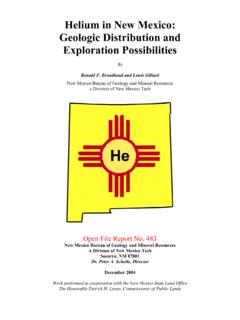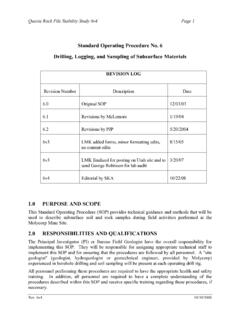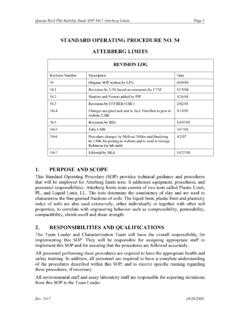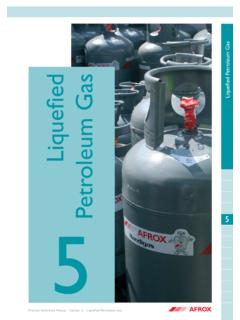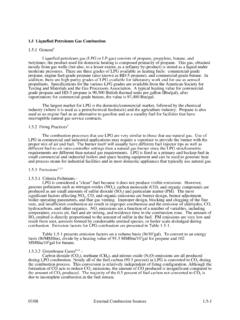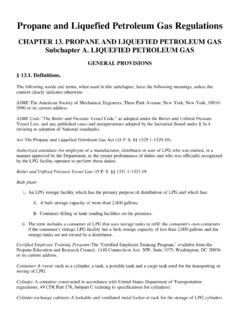Transcription of PETROLEUM GEOLOGY: AN INTRODUCTION
1 PETROLEUM geology : AN INTRODUCTION Ronald F. Broadhead, New Mexico Bureau of geology and Mineral Resources, a Division of New Mexico Institute of Mining and Technology INTRODUCTION The oil and natural gas that are produced from oil and gas fields reside in porous and permeable rocks (reservoirs) in which these liquids have collected and accumulated throughout the vast expanse of geologic time. Oil and gas fields are geological features that result from the coincident occurrence of four types of geologic features (Figure 1): (1) oil and gas source rocks, (2) reservoir rocks, (3) seals, and (4) traps. Each of these features is discussed and illustrated below and the role of each type of feature in our natural oil and gas system is emphasized. Figure 1.
2 Arrangement of oil and gas source rocks, a reservoir, a seal, and a trap in a way that has allowed the natural accumulation of oil and gas. From Broadhead1. OIL AND GAS SOURCE ROCKS Oil and natural gas originate in PETROLEUM source rocks2. Source rocks are sedimentary rocks that were deposited in very quiet water, usually in still swamps on land, shallow quiet marine bays, or in deep submarine settings. Source rocks are comprised of very small mineral fragments. In between the mineral fragments, are the remains of organic material, usually algae, small wood fragments, or pieces of the soft parts of land plants (Figure 2). When these fine-grained sediments are buried by deposition of later, overlying sediments, the increasing heat and pressure resulting from burial turns the soft sediments into hard rock strata.
3 If further burial ensues, then temperatures continue to increase. When temperatures of the organic-rich sedimentary rocks exceed 120o C (250o F) the organic remains within the rocks begin to be "cooked" and oil and natural gas are formed from the organic remains and expelled from the source rock. It takes millions of years for these source rocks to be buried deeply enough to attain these maturation temperatures and additional millions of years to cook (or generate) sufficient volumes of oil and natural gas to form commercial accumulations as the oil and gas are expelled from the source rock into adjacent reservoir rocks. Oil and gas formed in this manner are referred to as thermogenic oil and gas. If the organic materials within the source rock are mostly wood fragments, then then the primary hydrocarbons generated upon maturation are natural gas.
4 If the organic materials are mostly algae or the soft parts of land plants, then both oil and natural gas are formed. By the time the source rock is buried deeply enough so that temperatures are above 150o C (300o F), the organic remains have produced most of the oil they are able to. Above these temperatures, any oil remaining in the source rock or any oil that has been trapped in adjacent reservoirs will be broken down into natural gas. So, gas can be generated in two ways in the natural systems; it can be generated directly from woody organic matter in the source rocks or it can be derived by thermal breakdown of previously generated oils at high temperatures. Figure 2. Greatly magnified microscopic image of a source rock with mineral grains (lighter colored material) and pieces of organic matter that are mostly the remains of algae (dark material).
5 This source rock will also act as a seal. From Broadhead1. Some organic-rich sedimentary rocks can generate gas through bacterial processes at shallow burial depth before thermal maturation temperatures are attained. In this process, referred to as biogenic gas generation, the organic-rich source rocks are never buried very deeply and do not attain temperatures necessary for the thermogenic production of gas2, 3. Instead, anaerobic bacteria generate gas in shallow source rocks that are generally located around the basin margin. Biogenic processes produce less gas per unit volume of sediment than thermogenic processes. Gas wells associated with biogenic gas are usually low volume. Most accumulations of biogenic gas occur at depths of less than 2000 ft3.
6 OIL AND GAS RESERVOIR ROCKS Oil and gas reservoir rocks4, 5 are porous and permeable. They contain interconnected passageways of microscopic pores or holes that occupy the areas between the mineral grains of the rock (Figure 3). When oil and gas have been naturally expelled from source rocks, they enter or migrate into adjacent reservoir rocks6. Most oil and gas reservoir rocks are sandstones, limestones, or dolomites. Once oil and gas enter the reservoir rock, they are relatively free to move. Most reservoir rocks are initially saturated with saline groundwater. Saline ground water has a density of slightly more than g/cm3. Because oil and gas are less dense than the ground water (density oil = g/cm3 and density gas = g/cm3), they rise upward through the water-saturated pore spaces until they meet a barrier of impermeable rock (Figures 2, 4; a seal).
7 Seals generally are very fine-grained rocks with no pore spaces or pore spaces that are too small to permit the entry of fluids7. Figure 3. Greatly magnified microscopic image of a sandstone reservoir rock. The pore spaces may be occupied by oil, gas, or water. This is from the gas-productive sandstone of Figure 4. From Broadhead1. Figure 4. Core of a gas producing sandstone reservoir with the reservoir interval and the overlying shale seal indicated. See Figure 3 for microscopic view of the sandstone reservoir. OIL AND GAS TRAPS Once in the reservoir rock, the oil and natural gas continue to migrate through the pore spaces of the reservoir rock until all further movement of the oil and gas are blocked by physical arrangement of the reservoir rock and one or more seals.
8 This arrangement of the reservoir and seals is called a trap4, 5 (Figure 1). There are two main types of traps, structural and stratigraphic 4, 5. Structural traps are formed when the reservoir rock and overlying seal have been deformed by folding or faulting. Usually this deformation takes place tens of millions or hundreds of millions of years after deposition of the sediments that get turned into seals and reservoir rocks. The oil and gas migrate upward through the reservoir and accumulate in the highest part of the structure (Figure 5). If both oil and gas are present, the gas will from a layer (within the pore spaces) that rests above a layer of oil because the natural gas is less dense than the oil. The layer of oil will, in turn, rest upon the water-saturated portions of the reservoir.
9 Figure 5. Folded strata that form a structural trap. From Broadhead1. Stratigraphic traps (Figure 6) are formed when the reservoir rock is deposited as a discontinuous layer. Seals are deposited beside and on top of the reservoir. A common example of this type of trap is a coastal barrier island. Impermeable shale seals are deposited both landward and seaward of the barrier island, which forms an elongate lens of sandstone. The result is a porous sandstone reservoir surrounded by shale seals that may also be source rocks. Figure 6. A discontinuous layer of sandstone that forms a stratigraphic trap. From Broadhead1. COALBED METHANE Coals can act as both a source rock of natural gas and as a reservoir rock. When this is the case, coalbed methane "coal gas" can be produced8.
10 The gas is generated from the woody organic matter that forms the coals. At shallow burial depths, relatively low volumes of gas may be generated by bacterial processes within the coals. At greater burial depths where temperatures are higher, gas is generated thermally (like in conventional source rocks described above). Greater volumes of gas are generally formed by the thermal processes than by the bacterial processes, but coal gas has been produced from both types of sources. Most coals are characterized by pervasive systems of natural fractures (Figure 7). In the deep subsurface, these fractures are filled with water. The pressure exerted by this water on the coal holds the gas within the coals. In order to obtain gas production from the coals, the water must be first pumped out of the fractures.


